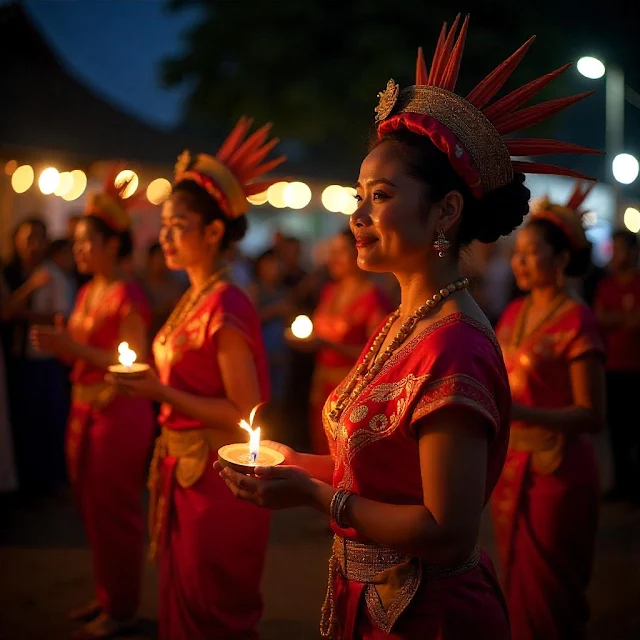The Mystical Power of Ngarot Tradition in Cirebon
 |
| The Mystical Power of Ngarot Tradition in Cirebon |
The Mystical Power of Ngarot Tradition in Cirebon
Introduction
Ngarot, a traditional ceremony originating from Cirebon, Indonesia, is a vibrant expression of local culture, spirituality, and community values. This unique event combines elements of performance art, ritualistic practices, and social commentary, making it a captivating focal point for both locals and visitors. In this article, we will delve into the origins, significance, rituals, and the mystical aspects of the Ngarot tradition, exploring how it continues to thrive in contemporary society.
Historical Background
Origins of Ngarot
Ngarot dates back to the Islamic era of the Sultanate of Cirebon in the 15th century. The word "ngarot" itself is derived from the Sundanese term for “to be intoxicated” or “to be ecstatic,” reflecting the euphoric state that participants often experience during the ceremony. Historically, Ngarot was a rite of passage for young men and women, symbolizing their transition into adulthood and their readiness to assume responsibilities within the community.
Cultural Influences
Cirebon is a melting pot of diverse cultures, including Javanese, Sundanese, and Chinese influences, which have all shaped the region's traditions. Ngarot incorporates elements from these various cultures, resulting in a unique blend that showcases the rich tapestry of Cirebon’s heritage. The tradition is often performed during important community events, such as weddings, harvest festivals, and religious ceremonies.
The Ritual of Ngarot
Preparation
The preparation for the Ngarot ceremony is an elaborate process that involves the entire community. Traditionally, participants, known as "ngarotists," engage in various activities leading up to the event, including rehearsals, crafting costumes, and gathering offerings. The atmosphere is filled with excitement and anticipation, as the community comes together to support one another.
The Ceremony
The Ngarot ceremony itself is a colorful spectacle that involves dance, music, and theatrical performances. Central to the event is the use of "kuda lumping," a traditional horse dance that features performers riding bamboo horses. This captivating dance symbolizes the spirit of freedom and joy, allowing participants to express themselves in a communal setting.
The ritual also includes various offerings to ancestral spirits and deities, emphasizing the spiritual significance of the event. Participants often experience trance-like states, believed to connect them with the divine, showcasing the mystical power of the Ngarot tradition.
Symbolism
Each element of the Ngarot ceremony is rich in symbolism. The costumes, adorned with vibrant colors and intricate designs, represent the beauty and diversity of the Cirebon culture. The dances depict themes of love, struggle, and triumph, resonating with the collective experiences of the community.
Mystical Aspects of Ngarot
Spiritual Connection
The mystical power of Ngarot is deeply rooted in its spiritual significance. Participants believe that the ceremony serves as a conduit for connecting with ancestral spirits and divine entities. This connection is not merely for personal gain; it is a communal experience that strengthens the bonds among participants and the broader community.
Trance and Possession
One of the most intriguing aspects of Ngarot is the phenomenon of trance and possession. During the ceremony, some participants enter a trance state, believed to be a form of spiritual possession. In this state, they often exhibit extraordinary abilities, such as performing acrobatics or delivering prophecies. This experience is viewed as a blessing, allowing individuals to transcend their ordinary selves and embody the spirit of their ancestors.
Healing Rituals
Ngarot also incorporates healing rituals, where participants seek blessings for health, prosperity, and protection. These rituals often involve the use of traditional herbs and offerings, with the belief that the spirits can grant protection and guidance to the community.
Contemporary Relevance
Preservation of Tradition
In recent years, there has been a growing awareness of the need to preserve traditional practices like Ngarot. With globalization and modernization threatening to erode cultural heritage, many communities in Cirebon are actively working to maintain and revitalize this ancient tradition. Educational programs, workshops, and festivals are being organized to teach younger generations about the significance of Ngarot and its cultural roots.
Ngarot in Modern Society
Today, Ngarot serves not only as a cultural ritual but also as a platform for social commentary. Artists and performers often use the ceremony to address contemporary issues, such as environmental concerns, social justice, and community solidarity. By integrating modern themes into the traditional framework, Ngarot remains relevant in the ever-changing societal landscape.
Tourism and Cultural Exchange
The allure of Ngarot has attracted the attention of tourists, researchers, and cultural enthusiasts. As a result, the tradition has become a focal point for cultural exchange, allowing people from different backgrounds to engage with and appreciate the richness of Cirebon's heritage. This engagement fosters mutual respect and understanding, promoting cultural diversity on a global scale.
Conclusion
The Ngarot tradition in Cirebon is a powerful testament to the resilience of cultural heritage in the face of modernization. Its mystical elements, rich symbolism, and communal spirit create a profound connection among participants and the broader community. As Ngarot continues to evolve, it remains a vital expression of identity, spirituality, and social commentary in contemporary Indonesia. The tradition not only preserves the past but also paves the way for future generations to engage with their cultural roots, ensuring that the mystical power of Ngarot endures for years to come.
In summary, the Ngarot ceremony is more than just a cultural event; it is a living embodiment of the values, beliefs, and aspirations of the Cirebon community. Through its vibrant rituals and spiritual connections, Ngarot stands as a powerful reminder of the importance of cultural heritage and the need to celebrate and protect it in an ever-changing world.
CERITA SIPULE
situs seputar cerita horor dan sejarah
Buka: Senin s/d Minggu 7:00 - 21:00
Tlp: 0857-4347-7278
CERITA SIPULE
Posting Komentar